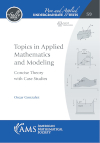- About MAA
- Membership
- MAA Publications
- Periodicals
- Blogs
- MAA Book Series
- MAA Press (an imprint of the AMS)
- MAA Notes
- MAA Reviews
- Mathematical Communication
- Information for Libraries
- Author Resources
- Advertise with MAA
- Meetings
- Competitions
- Programs
- Communities
- MAA Sections
- SIGMAA
- MAA Connect
- Students
- MAA Awards
- Awards Booklets
- Writing Awards
- Teaching Awards
- Service Awards
- Research Awards
- Lecture Awards
- Putnam Competition Individual and Team Winners
- D. E. Shaw Group AMC 8 Awards & Certificates
- Maryam Mirzakhani AMC 10 A Awards & Certificates
- Two Sigma AMC 10 B Awards & Certificates
- Jane Street AMC 12 A Awards & Certificates
- Akamai AMC 12 B Awards & Certificates
- High School Teachers
- News
You are here
Topics in Applied Mathematics and Modeling: Concise Theory with Case Studies

Buy Now:
Publisher:
AMS
Publication Date:
2024
Number of Pages:
210
Format:
Paperback
Series:
Pure and Applied Undergraduate Texts
Price:
85.00
ISBN:
978-1470469917
Category:
Textbook
[Reviewed by , on ]
Bill Satzer
03/30/2024
Subtitled “Concise Theory with Case Studies”, this book aims, according to the author, “… to provide a context for students to gain a deeper appreciation of mathematics and its connections with other disciplines.” It is intended for upper-level undergraduates in the mathematical and physical sciences and engineering who have a basic understanding of calculus, linear algebra, and ordinary differential equations.
In many ways the book is a kind of sampler that offers treatments of selected material of particular interest in applied mathematics. There are six main topics, each with its own chapter. These include dimensional analysis and scaling, dynamics in one and two dimensions, perturbation methods, and the calculus of variations. With these the author offers some of the basic tools that can be used in mathematical modeling.
Each chapter provides at least one case study and most have mini-projects as well as ordinary exercises. The case studies are perhaps the most notable feature of the book. They include, for example, bifurcation events for insect populations, the shape of a meniscus at a liquid-gas interface, and optimal design of a playground slide. Each of these is described in steps from setup to model outline to model analysis. The mini-projects ask students to carry out guided analyses of related applications.
Proofs of some results are provided in the first five chapters, and the author suggests only that the students read them. The proofs for the calculus of variations he regards as more essential, worthy of more detailed study.
The words “concise theory” are significant here, and may be of some concern for some students with less mathematical experience and maturity. Some topics are treated with more formality than one might expect given the minimal background the author expects. For example, in the first chapter, one dealing with dimensional analysis, students might be bewildered by the author’s formal treatment of Buckingham’s theorem on unit-free equations. This is not otherwise an inherently challenging subject, and a few concrete examples in advance of the statement of the theorem would have been helpful.
The mathematical formality continues on and off throughout the book. It’s possible that the author’s intention is to challenge readers in this way, but its prominence in just the first few pages of the text sets a tone that may immediately put off students.
This is nonetheless an attractive book in several ways, especially with the case studies and mini-projects, but it does raise some concerns about its match with parts of the target audience.
Bill Satzer (bsatzer@gmail.com), now retired from 3M Company, spent most of his career as a mathematician working in industry on a variety of applications. He did his PhD work in dynamical systems and celestial mechanics.
Bill Satzer (bsatzer@gmail.com), now retired from 3M Company, spent most of his career as a mathematician working in industry on a variety of applications. He did his PhD work in dynamical systems and celestial mechanics.
See the publisher's website.
- Log in to post comments




